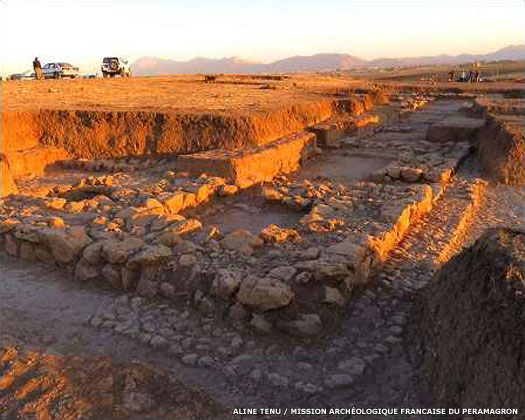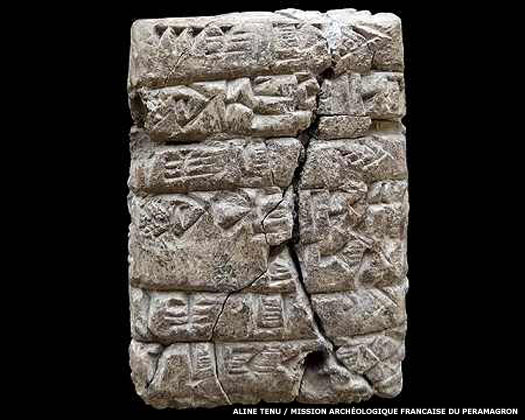
| LULLUBI Towards the end of the Sumerian period in ancient Mesopotamia, Sargon the Great created an Akkadian empire which truly unified Sumer and Akkad administratively for the first time ever. A military victory which was won by his grandson, Naram-Sin, was immortalised on a stele of pink limestone that is now exhibited at the Louvre Museum in Paris. On it, Naram-Sin is depicted triumphing over a people of the Zagros Mountains who were termed the Lullubi (or Lulubi). In the exclusively Mesopotamian sources that are available today, the Lullubi are depicted as 'barbarians', living a secluded life in the mountains. Until recently little more has been known about them other than that and other brief descriptions.
That changed over the course of six excavation campaigns that were conducted between 2012-2018. Archaeologists unearthed traces of an unexpected find in modern Kurdistan in northern Iraq - an ancient city at the site of Kunara. The city is located on the outskirts of the Zagros Mountains, on two small hills overlooking the right bank of a branch of the River Tanjaro, approximately five kilometres to the south-west of the city of Sulaimani (the modern day cultural capital of Iraqi Kurdistan). Previous excavations here were greatly hindered, first by Saddam Hussein and then by years of regional conflict. Only in the second decade of the twenty-first century have dealings with officialdom become much warmer and more productive.
The discovery at Kunara shone a new light on the indigenous pre-Indo-Iranian Lullubi. Archaeologists have theorised that the city may even have been the capital of the Lullubi, which if confirmed would create a whole new scope for their history. Far from living isolated from the ancient world, the inhabitants of Kunara built a thriving economy on agriculture, but then expanded into maintaining commercial relations with very distant regions both in the east (towards the Iranian plateau with its still poorly-researched city states) and in the north (toward the city states of Anatolia (such as Hattusa) and the Caucasus). They had writing in the form of cuneiform, and left some tablets at Kunara to describe some of their business dealings. The Lullubi in general, though, may not have been an identifiable ethnic grouping. The name very quickly came to mean 'highlander' thanks to the local terrain and may have encompassed various groups.
(Information by Peter Kessler, with additional information from Hethitsches Etymologisches Glossar, Johann Tischler (Vols 5 & 6, 1977-2001, in German), from The Cambridge Ancient History, edited by I E S Edwards, from Babylonian & Oriental Record (Vol 8, Issue 2 to Vol 9, Issue 2, 1886-1901), and from External Links: Historical 4,000-year-old lost city discovered in Iraqi Kurdistan (Ekurd Daily), and Encyclopaedia Iranica.)
c.2250 - 2220 BC :
Uz is claimed as the first-born son of Aram, who himself is the son of Shem in the genealogy of nations descended from Noah, ancestor of the Israelites. The Sumerian myth of Ziusudra exists in a single copy, the fragmentary Eridu Genesis, which is datable by its script to the seventeenth century BC (it may be this version which was adapted in Babylon from earlier sources, and was then rewritten for the Old Testament, compiled in the sixth century BC). It is the Old Testament version which confirms Noah as a revised Ziusudra, with the flood event itself being tentatively dated to 2900-2750 BC. Aram is a founder figure for Damas itself, as witnessed by the use of the name Aram Damascus in first millennium BC records.
The mysterious four thousand year-old lost city that was discovered on the site of Kunara, near Sulaimani city in Iraqi Kurdistan is thought to be a city of the Lullubi, an equally mysterious people of northern Mesopotamia The title of ensi found on certain clay tablets in Kunara signifies both 'king' and 'governor'. Its mention in addition to that of the title of sukkal - a senior state dignitary - evokes a political administration that is based on the Mesopotamian model. Could this be a simple borrowing from its powerful neighbour, the Akkadian empire, or a mark of submission to that empire.
fl c.2240s? BC :
Sidur : Prince of the Lullubi. Defeated by Naram-Sin.
fl c.2240s? BC :
Satuni / Sutuni : Prince of the Lullubi. Defeated by Naram-Sin.
It is around this time that Naram-Sin conquers Kunara and the Lullubi themselves of the region of 'Lulubum', as shown by his victory steles. Two princes of the Lullubi are named as being defeated by Naram-Sin, but this is their only mention in history.
c.2210s - 2193 BC :
The
Gutians sweep through southern Mesopotamia and overthrow both Elam
and the Akkadian empire, either during Naram-Sin's reign or that
of his son, ending Sumerian/Akkadian domination of the region. However,
the Gutians have already taken over as the dominant force over the
Lullubi, as it is against them that the Lullubi rebel.
fl c.2210s? BC :
Anubanini : 'Mighty king of Lullubium'. Rebelled against the Gutians.
Anubanini is a contemporary of Iddin-Sin of Simurrum. Together they rebel against the Gutian control of Eridu-pizir, presumably regaining the independence of both peoples. Anubanini is best-known for his 'Anubanini petroglyph', a rock relief in the modern Kermanshah province of Iraq. Lullubi rock reliefs are amongst the oldest in the region, even predating those of Elam.
The first cuneiform tablets to be discovered during the Kunara excavation is shown here, recording the very everyday delivery of different types of flour It would seem that, under Anubanini, the Lullubi become regionally powerful for a short time, raiding as far as the Persian Gulf and Elam. Classifying Anubanini himself as Lullubi, however, cannot be confirmed. Around the same time both Sumer and Egypt endure a short (climate-induced) dark age at this time which lasts for at least a century. The Lullubi probably retain their independence during this period.
c.2100s BC :
In the north the Hurrians are already arising as a notably separate group which is beginning to dominate the upper Tigris Valley and the upper Euphrates. Immashku, king of Lulu, is recorded in an historical-mythological fragment from Bo?azköy. This fragment stems from the Hurrian tradition which states that there are several Lullubian kings at the same time, presumably with a great king (a king of kings) controlling several chieftains (who are also termed kings).
Immashku : Over-king of the Lullubi? No dating available.
c.2000s BC :
The Lullubi continue to crop up in the historical record. Their cities are raided at least nine times by Shulgi of Ur in the middle years of the 2000s. It would seem that the last raid at least turns into domination or conquest. Shulgi's son, Amar-Sin, has Lullubians forming a contingent in his armies.
Little else is known of the Lullubians (or more often at this time the Lullu of Lullim). Nebuchadnezzar of Babylon claims to subdue them in the 1100s. To the east of Kunara, the Assyrians are still a minor power, but in time they will rise to dominate all of northern Mesopotamia, which includes Kunara. Their king, Tiglath-Pileser I, also claims to subdue the Lullubians (somewhere close to 1100 BC), after which they are subsumed within the Assyrian empire and disappear as an individual people. Their region of Lullubium, though, is still subject to Assyrian actions when suppressing revolts (notably in 881 BC).
Cyrus
the Great freed the Indo-Iranian Parsua people from Median domination
to establish a nation that is recognisable to this day, but did
he also destroy a possible renewed independence of the Lullubians?
It could be the Lullubians who are mentioned in connection with the Persian conquests of Cyrus the Great around 547 BC. Cyrus moves his army to the Tigris, below Arbela (which is probably today's Erbil, a short way to the east of the modern flow of the Tigris). He marches against the land of Lu-[?], and kills [?], its king, before taking booty, and setting up a garrison there. Unfortunately the name of the land is not quite legible. Various guesses have been taken, and the location of Erbil on the western edge of the Zagros Mountains makes it possible that the people are the Lullubians, seemingly with a restored independent kingship.
Source :
https://www.historyfiles.co.uk/ |


